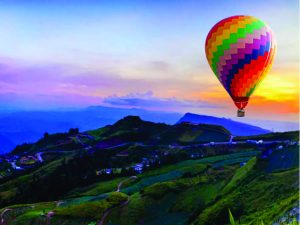Deep in the Satpura ranges of Madhya Pradesh lies Patalkot, a mysterious valley wrapped in greenery, peace, and tribal legends. Located about 78 km from Chhindwara town, this naturally formed valley is one of the most isolated and lesser-known destinations in central India.
Spread across nearly 80 square kilometers, Patalkot drops about 1,200 to 1,500 feet below the surrounding hilltops, creating a natural amphitheater filled with thick forests, flowing streams, and remote villages.
For travelers seeking something beyond the usual tourist trails, Patalkot is a revelation. It offers raw landscapes, ancient tribal wisdom, and an atmosphere so tranquil that time itself seems to slow down.
Why Patalkot is Special
1. A Living Heritage of the Bharia Tribe
The Bharia and Gond tribes have been living in Patalkot for centuries and have preserved traditions that the outside world has forgotten.
The Bharias are known for their herbal medicine. Local healers called Bhumkas use forest herbs to treat everything from fever to joint pain. Their knowledge has been passed down orally through generations and is still practiced today.
You can meet these healers through community visits, learn about forest conservation and how the valley supports their traditional way of life. Every leaf, bark and flower here has a story of survival and living in harmony with nature.
Also, don’t miss visiting Kangra valley Dharamshala
2. A Valley That Feels Timeless

Patalkot’s landscape is untouched by modernity. The valley is surrounded by high cliffs and dense forests that block sunlight in some places and create a mystical ambiance.
The Doodhi River flows gently through the valley and nourishes the farmlands and small settlements along its way. The air is filled with the smell of wet earth, wild flowers and fresh mahua blossoms.
Unlike most tourist places, Patalkot is not commercialized. There are no shops or loud crowds — only the sound of birds, rustling leaves and flowing water. For those who love solitude and nature, this valley is a personal heaven.
3. A Model for Responsible and Sustainable Tourism
In recent years, Patalkot has begun to appear on the map for eco-conscious travelers. Local authorities and community groups are encouraging responsible tourism that benefits the villagers and protects the environment.
Small homestays and community-run lodges have started to open near the rim and within accessible villages. Guests can enjoy authentic local food, participate in farming or craft workshops, and directly contribute to local incomes.
This shift toward sustainable tourism helps preserve culture while giving travelers an authentic, ethical experience.
Feature of the Patalkot

This place is known for its culture, history and geographical environment. As far as the eyes turn, only greenery and peace can be seen. The place is situated so deep that even the sunlight does not reach here. Even the day looks like a black sheet of night. As the night approaches, the forest becomes more dense and more scary along with it. Animal sounds start coming.
Mythology of the Patalkot

A massive bowl-shaped rock in Patalkot hides a 100-foot-long and 25-foot-wide cave known as Rajakhoh. According to local legends, Raja Raghuji of Nagpur rebelled against British rule, but when the British forces became a danger to him, he sought refuge inside this cave. Since then, the place has been called Rajakhoh. Rajakhoh has huge trees and wild vines.
Another belief about the place is that Ravana’s son Meghnath went to Patal Lok from this place after worshiping Lord Shiva. Because of which it is said about this place that it is the door to go to Hades. Also Visit Rishikesh The Land Of Lord Shiva.
People of Patalkot

People used to live in this valley of Patalkot since ancient times. He was living his life with great difficulty. The government had no information about this valley. People live in this valley.
All the people who lived in this valley did not have any kind of facilities and they were living their life like this. But when the government came to know about this valley, then the government has made a good road here. Electricity has been arranged here and Anganwadi and school have been opened here for the education of the people. A hospital was opened here for treatment.
Best time to spend time in Patalkot
The best time to visit is October to March when the weather is cool and clear. Monsoon (June to September) makes the valley a green paradise but the trails are slippery. Summer (April–June) is warm but excellent for birdwatching and photography.
How to Reach Patalkot
Reaching Patalkot requires some planning but the journey is as good as the destination.
By Road: From Chhindwara to Tamia (about 70–80 km) takes 2–3 hours through hills and curves. The last stretch to Patalkot is through forested slopes and offers great views.
By Air: Nearest airports are in Nagpur (200 km) and Jabalpur (240 km). From either city you can hire a car or taxi to Chhindwara and then to Tamia, the nearest town to the valley.
By Train: Chhindwara Railway Station is connected to Bhopal, Indore and Nagpur. From there you can hire local taxis and buses to Tamia and Patalkot.
Things to Do in Patalkot
- Trek through the Valley: The trails tend to be moderately difficult and pass through dense forests and streams.
- Visit the Bharia Healers: Find out how they identify and make the herbal medicines.
- Village Experience: Participate with local family to make some food or farm.
- Photography & Birdwatching: Take pictures of the sunrise from the rim, or perhaps you will see rare birds, such as the Indian Paradise Flycatcher or Malabar Whistling Thrush.
- Stargazing: There is very little light pollution in Patalkot valley and you are rewarded with a spectacular view of the night sky.
Stay & Food Options
Patalkot does not have much in terms of infrastructure but the nearby town of Tamia does have places to stay that are comfortable in government lodges or private homestays.
Most accommodations offer simple vegetarian meals that are made with locally grown produce such as millets, pulses and forest herbs. Do try any traditional dishes that may use mahua flowers, forest honey or just say freshly picked greens.
It is a good idea to book your time in a homestay managed by local families or communities—this way your money goes towards local development and it also gives you a more thorough cultural experience.
Approximate Travel Costs
- Taxi from Chhindwara to Patalkot (Round Trip): ₹3,000 – ₹5,000
- Local Guide (Half Day): ₹800 – ₹1,500
- Homestay/Guesthouse Stay: ₹700 – ₹1,500 per night
- Meals: ₹200 – ₹400 per person per meal
(These are approximate 2025 prices and may vary based on season and type of accommodation.)
Why You Should Visit Patalkot Now
Patalkot is not just a destination — it’s a reminder of what unexplored India looks like.
The valley gives travelers a chance to slow down, disconnect from noise and connect with something pure. You see how people live in sync with nature, using minimal resources and maximum wisdom.
With community based tourism gaining importance, visiting Patalkot today also means helping preserve its ecosystem and cultural heritage. Every responsible traveler who visits contributes in keeping this valley as pure for future generations as it is today.
Final Thoughts
Patalkot is one of the last few valleys in India where nature and human life coexist. It’s quiet, far off and real. Whether you are a traveler, trekker or a storyteller — this hidden valley will tell you that true journeys are not about distance but about depth.
FAQ’S
For a very long period, Patalkot has maintained its unique culture and customs. It was a world unto itself with no outside impact until a few years ago. to market ecotourism as a collaborative product and stop the deforestation and forest degradation process.
No commercial hotels or resorts exist inside Patalkot Valley to preserve its natural ecosystem and tribal culture. However, eco-friendly homestays and forest rest houses are available in nearby villages like Tamia and Harrai. These accommodations offer basic amenities and a closer look at tribal lifestyles. Booking through the Madhya Pradesh Tourism website or local tour operators is the best way to arrange your stay safely.
Yes, Patalkot is home to ancient tribes such as the Bharia and Gond communities. Travelers can experience their herbal medicine practices, traditional dance forms, and age-old festivals like Bhagoria and Karma. Responsible tourism initiatives now allow visitors to engage in guided village walks and handicraft workshops without disturbing tribal privacy.
Absolutely. Patalkot is safe for solo travelers and nature lovers, provided they travel with local guides or approved eco-tour operators. The forest trails can be steep and remote, so a guided trek ensures safety and access to hidden viewpoints. Always carry enough water, wear trekking shoes, and avoid exploring alone after sunset due to limited network connectivity and wildlife movement.







You must be logged in to post a comment.